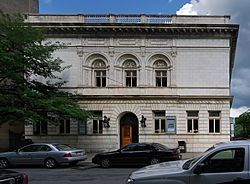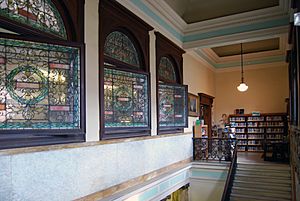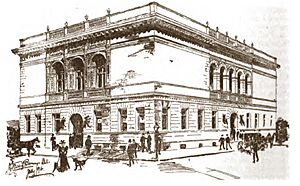Troy Public Library facts for kids
Quick facts for kids Troy Public Library |
|
|---|---|
 |
|
| Established | 1799-1800 |
| Location | 100 Second Street, Troy, New York 12180 |
| Coordinates | 42°43′40.5″N 73°41′31.1″W / 42.727917°N 73.691972°W |
| Branches | 3 |
| Other information | |
| Budget | $800,000 |
| Website | http://www.thetroylibrary.org |
The Troy Public Library is the main library building in Troy, New York. It is located right across the street from Russell Sage College in downtown Troy. This library helps people of all ages find books, learn new things, and connect with their community.
The very first library in Troy started way back in 1799. The building you see today was finished in 1897. It is so special that it is listed on the National Register of Historic Places. This means it is an important historical building. It is also part of the larger Central Troy Historic District.
The Troy Public Library once had other locations. The Lansingburgh branch was temporarily closed in 2009. The Sycaway branch also closed temporarily in 2009 and then permanently in 2011.
Building the Troy Public Library
The money to build this beautiful downtown library came from a generous gift. Mary E. Hart donated the funds. She wanted to honor her late husband, William Howard Hart. That is why the building is sometimes called the Hart Memorial Building.
The library was designed by a famous architecture firm. Barney and Chapman from New York City created its plans. The building shows off the "American Renaissance" style. This style became popular after the 1893 World's Columbian Exposition in Chicago. This big event showed off many new ideas in art and building design.
Other buildings from this time also use the American Renaissance style. Examples include the Villard Houses and the Low Memorial Library at Columbia University. The Boston Public Library is another famous example.
What the Library Looks Like
The outside walls of the Troy Public Library are made of white Vermont marble. The first floor has a rough, textured look. This is called rusticated stone. The upper floor uses smooth, cut stones. This creates a nice contrast.
The building has decorative stone details. These include carved stone lines and a cornice at the top. The three windows on the Second Street side have very detailed carvings around them. The Ferry Street side has a covered walkway on the second floor. This is called a loggia.
The top of the building has a stone parapet. There is also a decorative railing, called a balustrade, above the entrance. In 1972, experts described the library. They called it "one of the finest examples of Italian Renaissance style in this country."
Inside the library, you can find a special tiffany glass window. This beautiful window shows a famous Venetian scholar and printer named Aldus Manutius.
Images for kids




